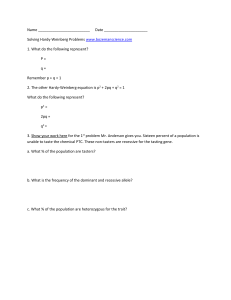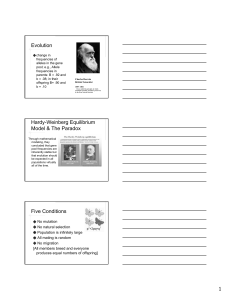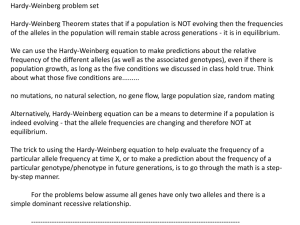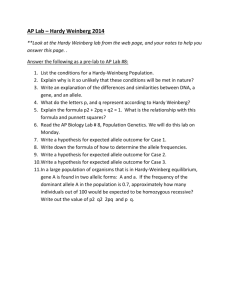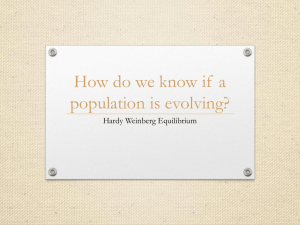8.5 - Allelic Frequencies & Population Genetics
advertisement
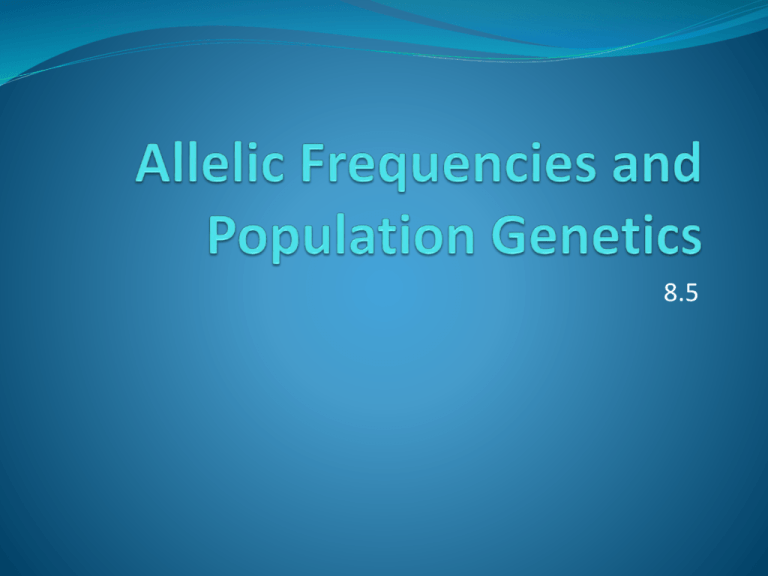
8.5 Starter What is the term for all the alleles of all the genes in a population? Gene Pool What do you think the term would be for the number of times an allele occurs within a gene pool? Allelic Frequency Learning Objectives Describe the terms ‘gene pool’ and ‘allelic frequency’ Explain what the Hardy-Weinberg principle is Explain how the Hardy-Weinberg principle can be used to calculate allele, genotype and phenotype frequencies Allelic Frequencies Every person has 2 alleles of a gene (e.g. TT, Tt or tt) If a population has 5000 people, then there are 10,000 alleles of each gene The total number of alleles in a population is said to be 1.0 Allelic Frequencies Frequencies of the 2 alleles must add up to 1.0 A recessive/dominant situation If everyone in a population was TT, then what would the frequency of the T allele be? 1.0 If everyone in a population was Tt, then what would the frequency of the T allele be? 0.5 The t allele? 0.5 However, realistically you see a mixture of genotypes in a population, so this way of working out allele frequencies cannot be used. We must use the Hardy-Weinberg Principle The Hardy-Weinberg Principle An equation to work out the frequencies of the alleles in a population To use the equation the following 5 things must be true: No mutations Population is isolated No selection Large population Mating is random The Hardy-Weinberg Principle The equation = p2 + 2pq + q2 Frequency of allele T = p Frequency of allele t = q So, p + q must equal 1.0 Four possible arrangements of the alleles: TT, Tt, tT, tt which must equal 1.0 Times them together to create the equation: p2 + 2pq + q2 Example Work out, using the Hardy-Weinberg equation, the allele frequencies of cystic fibrosis, a recessive condition affecting the lungs. In a population of 15,000 people, 1 person suffers from the disease. Recessive, so the frequency of tt = 1/15000 So, q2 = 1/15000 = 0.000067 So, q = square root of 0.000067 = 0.0081854 = 0.0082 p + q = 1.0 So, 1.0 – q = p p = 1.0 – 0.0082 = 0.9918 (This is the frequency of allele T) Example Now that we know p and q we can work out the frequency of heterozygous individuals in the population Heterozygous = 2pq = 2 x 0.9918 x 0.0082 = 0.0163 This means 163 individuals in 10000 are carriers for the recessive allele and could potentially pass on cystic fibrosis. This is equivalent to 244 people in our 15000. Task Complete application questions on page 127 1. Not sex linked as approximately equal numbers of males and females in each colour. 2. 562/2215 = 0.254 3. a) q = Square root of 0.254 = 0.504 b) p + q = 1.0. p = 1.0 – 0.504 = 0.496 c) Heterozygotes = 2pq = 2 x 0.496 x 0.504 = 0.5, so heterozygotes = 50% 4. Collect a sample of moths. Mark them unobtrusively. Release back into the population and allow time to mix. Later, randomly catch a sample and count the number of marked and unmarked moths. Calculate by: (total number in first sample x total number of moths in second sample) / number of marked moths recaptured Exam Question on H-W 1. (a) (b) (q2 = 0.52 / q = 0.72) (p = 1 – 0.72 = 0.28) p + q = 1 / p2 + 2pq + q2 = 1 ; Answer = 2pq / use of appropriate numbers; Answer = 40%; 3 Any three from: (MARK AS A WHOLE) Small founder population / common ancestor; Genetic isolation / small gene pool / no immigration / no migration / in-breeding; High probability of mating with person having H-allele; Reproduction occurs before symptoms of disease are apparent; Genetic argument – Hh x hh ® 50% / Hh x Hh ® 75% affected offspring; No survival / selective disadvantage; 3 max Ignore ‘survival of the fittest’ [6] Task You will be given a selection of sweets to represent alleles in a population The type with fewer present will be the recessive allele and the other the dominant Work out q, then p Then calculate the frequency of heterozygous individuals in the population
